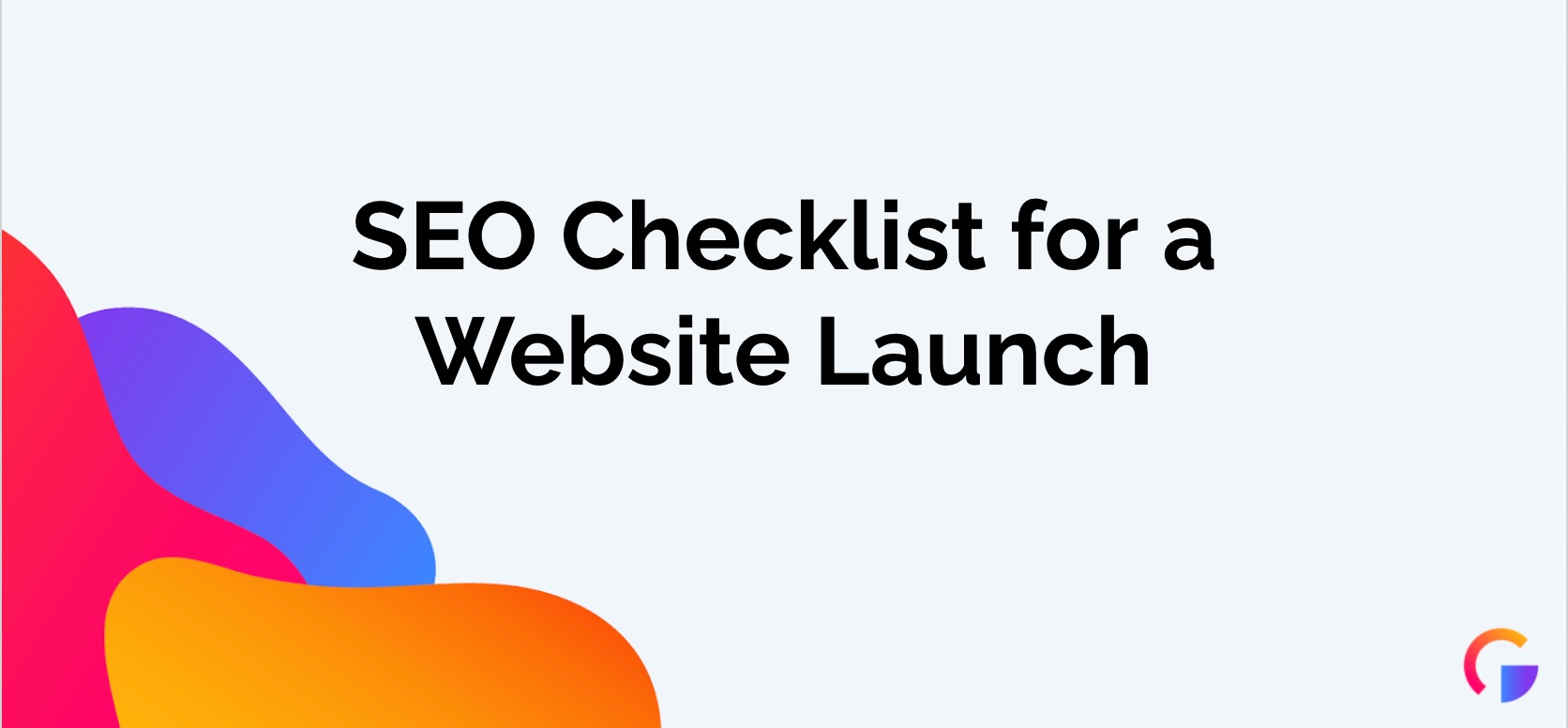
The Essential SEO Site Launch Checklist [Free Template]
Written by: CRO:NYX Team
Published: 28 August, 2025
If you're launching a brand new site or refreshing an existing one, it is absolutely essential that you consider SEO early in the process. Failing to do so is the number one reason businesses see their traffic and leads disappear after a relaunch.
The key to avoiding disaster is preparation. A poorly planned website launch can lead to broken links, lost content, and confusing signals to search engines, resulting in a loss of conversions and a significant drop in organic search visibility (sometimes going down to zero).

This is why having a detailed SEO checklist isn't just helpful or nice to have. It's your business's primary insurance policy against a massive headache and lost revenue.
Our goal is to walk you through every critical step, from pre-launch planning to post-launch monitoring, and provide you with the free downloadable template that will empower you to manage the process effectively.
Disclaimer: This checklist is a powerful tool, but it isn't a replacement for an experienced SEO specialist. SEO is nuanced, and a successful launch requires a deep understanding of how all the pieces work together.
You don't have to do it alone, you know. If you are already feeling overwhelmed, let our experts handle your website launch from start to finish.
By the way, we also hosted a HubSpot User Group (HUG) event that was focused entirely on this topic. We have a recording of the event for you below, as well as the free template itself.
Watch the recap: Your SEO will thank you
SEO Site Launch Free Checklist Template
If you want to skip straight to using our template, feel free to.
We give a bunch of information within the template that should guide your website launch process. In case you are in doubt,you can get back to this article or the video for an in-depth explanation.
Part 1: Pre-Launch Planning (The Foundation for Success)
Thorough preparation is the most critical phase of a website launch, as we already mentioned.
Getting this part right will save you from frantically playing "spot the difference" with your old site after it's already gone.
1.1 Audit & Document Your Current Site
Before you can build something new, you ideally need a blueprint of what already exists.
Documenting everything prevents valuable pages and SEO elements from being lost in the transition.
What you need to document:
- All URLs - Every single page, PDF, and important image file.
- SEO Elements - Title tags, meta descriptions, H1 tags, and other header tags for every key page.
- Content - Ensure all valuable body copy is accounted for, especially on high-performing pages.
- Status Codes - Identify any existing redirects (301s) or broken pages (404s) that need to be addressed.
How to do it: Use a web crawler like Screaming Frog. You can crawl your live site and the new site in its staging environment to compare the two. Export these crawls into an Excel file to have a permanent record.

Our downloadable template is a good place for you to log all this information, making it easy to track and share with your team.
Don’t Forget to Create a 1-to-1 Redirect Map
This is your most important document for preserving the authority your old site has built.
A redirect map is a simple spreadsheet that lists every old URL and matches it to the corresponding new URL.
Make sure you avoid the catastrophic mistake of redirecting all old pages to the new homepage; this tells Google your new pages aren't relevant and can erase your rankings.

1.2 Establish Your SEO Baseline
You cannot prove the success of your launch (or diagnose problems) if you don't have a clear picture of your performance beforehand.
What to measure:
- Keyword rankings - Use a tool like Ahrefs or SEMrush to export your current keyword rankings. This data is often hard to get historically, so save it now.
- Organic traffic - Document your organic traffic levels, top-performing pages, and traffic sources.
- Conversions - Document your current conversion rates, key events, and goal completions.
- Other key metrics - Note any other business-specific KPIs you track.
1.3 Configure Analytics & Tracking

There is nothing worse than launching a new site and realizing a week later that your analytics weren't tracking. You can never get that missing data back.
What to set up:
- Google Search Console (GSC) - Set up a new property if it's a new domain.
- Google Analytics (GA) & Google Tag Manager (GTM) - Install your tracking codes on the staging site before launch. Test every event and goal. A new site often means new button classes, form IDs, or thank-you page URLs, which will break your existing triggers.
1.4 Identify Technical SEO Opportunities
A website relaunch is the perfect time to fix nagging technical SEO issues and not have to carry them over. Use your earlier site crawl from Screaming Frog to identify:
- Internal redirects - Fix any redirect chains.
- HTTP/HTTPS & WWW/Non-WWW versions - Ensure you're consistently using one secure, canonical version of your domain.
- Canonical tags - Check for any issues with duplicate content.
- XML sitemap & robots.txt - Review your current files for errors.
- Noindex, Nofollow Tags - Make sure you aren't unintentionally blocking important pages.
- Schema markup - Review and implement structured data for your organization, services, or products.
- Core web vitals - Address any site speed and performance issues before they get migrated to the new site. You can hook PageSpeed Insights API from Google into your Screaming Frog (for free) to get all Core web vitals data for each individual page.

Further reading: Are you looking to improve Core Web Vitals on your HubSpot site?
Part 2: The Final Countdown (Just Before Going Live)
On the final day before launch, it's time for the last critical checks and actions.
2.1 Implement Redirects & Finalize the XML Sitemap
Take your redirect map and implement all the 301 redirects. This can be done via a plugin, your server's .htaccess file, or within your CMS (like HubSpot).
Next, generate an updated XML sitemap for the new site.
- Include: All the pages you want Google to index, including important images, PDFs, and videos.
- Exclude: Thin content pages like author archives (if they aren't robust), category pages you don't want indexed, and any gated landing pages.

2.2 The Single Most Important Step: Update Your robots.txt File
This is, without a doubt, the most common and damaging mistake made during a website launch.
Developers rightly block search engines from crawling a staging site to prevent it from being indexed.
They typically do this by adding this line to the robots.txt file:
User-agent: * Disallow: /
This Disallow: / command tells all search engine bots not to crawl any pages on the site.
If this line is not removed when you go live, your entire website will be de-indexed, and your organic traffic will flatline.
Double-check and then triple-check that this rule is removed before you launch.
2.3 Cross-Browser and Device Testing

Manually check your new site on Chrome, Safari, and Firefox, as well as on a desktop, tablet, and smartphone.
What looks great on one device can be broken on another.
Also, you have to ensure your site is usable for people with disabilities. This is not only good for users but is also becoming an important legal and SEO consideration.
Part 3: Post-Launch Monitoring & Optimization
Your work isn't done when the site goes live. Now it's time to monitor, verify, and fix.
3.1 Your First 24 Hours: Immediate Technical Review
- Submit new sitemap - Go to Google Search Console and submit your new XML sitemap to prompt Google to crawl your new pages.
- Test redirects - Manually test a sample of your redirects to ensure they are working correctly.
- Run a new crawl - Use Screaming Frog on the live site to immediately catch any 404 errors, broken links, or missing SEO elements.
- Check analytics - Verify that your analytics are receiving live data.
- Check integrations - Verify that all third-party tools (CRM, email marketing, analytics) and social media share links are functioning correctly.
3.2 Your First Month: Ongoing Monitoring

- Monitor Google search console - Keep a close eye on the "Coverage" report for any errors or a drop in indexed pages. Check the "Core Web Vitals" and "Mobile Usability" reports, as well.
- Find and fix 404s - GSC will show you if users or other websites are trying to access old URLs that you may have missed in your redirect map. Add redirects for these as you find them.
- Update off-site links - Remember to update the links on your social media profiles, Google Business Profile, email signatures, and any important directory listings.
- Schedule backups - Confirm that your automated website backup schedule is active and running.
3.3 Reporting on the Launch
When reporting on the launch, always tie your data back to the primary business objectives.
- SEO KPIs vs. business KPIs - While a drop in rankings for an irrelevant, high-funnel keyword might look alarming, it may be irrelevant if the new site is converting more qualified leads, which is the business KPI.
- Wait for meaningful data - Don't run a full performance report on day one and make decisions based on it. Wait at least a month or two to gather enough data to see real trends in traffic, rankings, and conversions.
4.0 Announcing Your New Website
A launch isn't just a technical task, it's also an actual marketing opportunity.
You should plan your communication strategy to let your audience know about your new and improved website.
Launch Communication Checklist
- Draft an email announcement for your subscribers.
- Prepare social media posts for all your channels.
- Write a blog post highlighting the new features and benefits of the site.
- Notify your team and any key stakeholders internally.
Website Launch Message Sample (for email)
Subject: We've got a brand new look! Check out the new [Your Company Name] website.
Hi [Name],
We're thrilled to announce the launch of our newly redesigned website! We've been working hard to create a better experience for you, with a fresh look, improved navigation, and more valuable resources.
Come see what's new: [Link to your new homepage]
We hope you like the changes. We'd love to hear your feedback!
Best, The [Your Company Name] Team
5.0 Platform-Specific Launch Considerations
While the core principles of a website launch are universal, different platforms have their own unique quirks and features.
Here are a few specific things to keep an eye on for WordPress, Shopify, and HubSpot.
For WordPress

- Plugin audit - A new theme can often cause conflicts with old plugins. Deactivate and delete any plugins you no longer need, and test all remaining plugins thoroughly on the staging site.
- Permalinks - When launching, double-check that your Permalinks settings (under Settings > Permalinks) are set to your desired structure (usually "Post name"). Sometimes this can reset during a migration.
- Backup plugins - Ensure your backup solution (like UpdraftPlus or a host-level backup) is active and has successfully completed a full site backup right before you go live.
In case you are having troubles with WordPress, make sure you read our guide on how to build an optimized WordPress website. It will equip you with everything you need to know.
For Shopify / E-commerce
- Product & collection URLs - Pay close attention to your URL structure. If your URLs have changed, ensure every old product and collection page is redirected to its new equivalent to preserve SEO value.
- Checkout process - Run several test transactions to ensure the entire checkout funnel is working flawlessly. Check payment gateways, shipping calculators, and transactional emails.
- Product schema - Verify that your product schema (structured data) is implemented correctly to be eligible for rich snippets like pricing and availability in search results.
For a real-world example of how a strategic relaunch and redesign drove a 37% increase in website conversion rates, check out our e-commerce SEO case study.
For HubSpot
- Tracking codes - HubSpot's power comes from its tracking. Go to your settings under "Tracking & Analytics" and ensure the tracking code is properly installed on all new pages and subdomains.
- Forms & CTAs - Test every single form and call-to-action. A new theme can interfere with how they are rendered or tracked. Make sure new submissions are correctly flowing into your contact lists and workflows.
- Redirect Tool - Use HubSpot's built-in redirect tool (under Settings > Website > Domains & URLs). Be aware that if you had redirects on your old site (also on HubSpot), you need to ensure they don't conflict with any new redirects you're adding.

Most Asked Questions About Website Launch
These are some of the most common questions we get about website launches.
Will my rankings plummet if I change my content?
It depends. If you've done your pre-launch planning correctly, mapped your redirects, and maintained or improved the quality of your content, you should be able to maintain your rankings.
However, if you consolidate content and remove pages that brought in significant traffic, you will likely see a drop.
The key is to analyze the quality of that traffic and align it with your business goals.
Should I launch overnight or on a Friday?
While launching during low-traffic hours (like overnight) seems smart, it can be risky if you're a small team.
If something goes wrong, you may not have the support resources available to fix it.
And never, ever launch on a Friday. A Friday launch that goes wrong means you'll be working all weekend to fix it.
Do I need to redirect pages I think are unimportant?
Yes. Even if a page seems unimportant to you, it might have valuable backlinks pointing to it or receive a small amount of traffic.
Leaving it as a 404 error creates a bad user experience and results in a lost opportunity.
Redirect it to the most relevant new page.
What if I'm launching a website for multiple countries or languages?
This is a more complex scenario known as international SEO.
The key is to clearly signal to Google which version of your site should be shown to which users. This typically involves two main components:
- URL structure - Deciding whether to use country-specific domains (yourbrand.de), subdomains (https://www.google.com/search?q=de.yourbrand.com), or subdirectories (yourbrand.com/de).
- Hreflang tags - These are code snippets that tell search engines which language and country each page is targeting.
A global launch requires careful planning, and getting it wrong can cause significant indexing problems.
We highly recommend consulting with an SEO specialist if you're targeting multiple regions.
What are the most common reasons rankings drop after a launch?
The top three culprits are:
- Forgetting to remove the Disallow: / rule in robots.txt. (The number one issue!)
- A poor redirect strategy, such as redirecting everything to the homepage instead of creating 1-to-1 matches.
- Significant content removal or consolidation without a clear understanding of what pages were driving traffic and rankings.
Beyond the Launch: What's next?
It's tempting to see a website launch as the finish line, but for your business's growth, it's likely just the starting point.
Your new website might have a powerful foundation, but in SEO, you need continuous effort and multiple iterations to achieve its full potential.
If you have now successfully launched, it's time to shift your focus from migration to momentum.
Here’s what you should be thinking about next:
- Monitor & iterate - Continue to track your traffic and conversions. Use this data to identify what's working and what's not, and make improvements based on that data.
- Build a content strategy - Your new site always needs fresh, high-quality content to attract new customers.
- Focus on authority building - Proactively seek out high-quality backlinks from reputable websites to build your site's authority.
- Conduct regular technical health checks - SEO isn't static. Run regular health checks (at least quarterly) to catch and fix problems before they impact your rankings.
Ready to grow, but not sure where to start?
This checklist is a great first step.
When you're ready to turn your new website into a powerful engine for growth, our team is here to help.
Download the free checklist template or schedule a free consultation with us!
Send me the checklist!
Want this checklist in your email?
Written by: CRO:NYX Team
News and articles from CRO:NYX team members & alumni.
Solutions
Results
Resources
About
Contact
© CRONYX Digital SEZC







.png)
.png)
.png)
